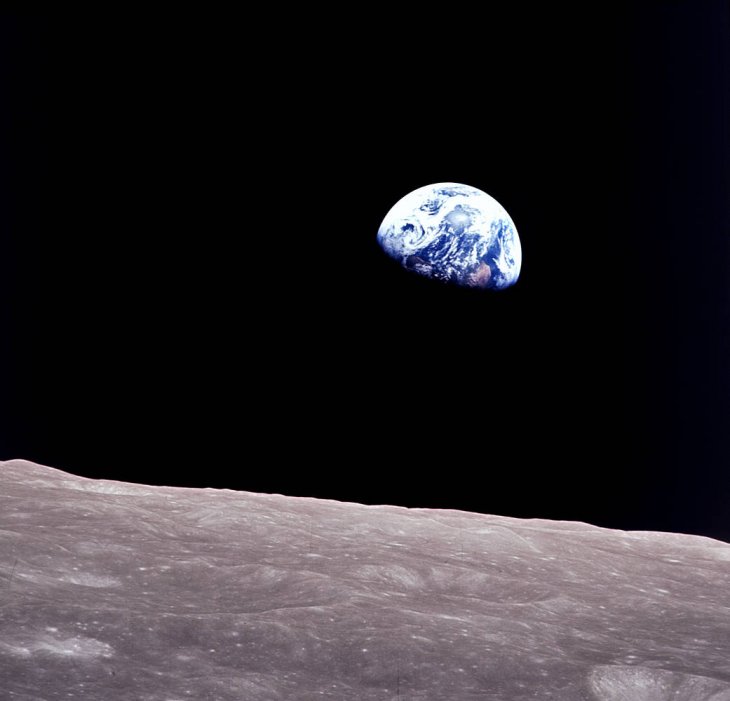Last week, 50 years ago, Apollo 17’s lunar module left the moon. Since then, no one has set foot there. Let us pause for a moment to think about the signficance of that rather unique adventure called Apollo.

Earthrise. Captured by Bill Anders on Christmas Eve 1968. Photo: NASA
The Apollo program defies belief. At a time when much of modern technology – not least computer technology – was in its infancy, and immensely simpler than it is today, NASA managed to land human beings on the moon. It was, and remains, a daunting and dangerous task: to send living human beings into the airless void of space and then to land safely on – and not least return safely from – the surface of another heavenly body.
There was much criticism at the time, not least about the funds being spent on such an extravagant project as desparate troubles from famines to brutal wars were engulfing our own planet. Yet, if human beings are ever to explore other planets and worlds, and to understand and solve our own challenges from the vantage point of space, getting to the moon is an indispensable part of the process.
As importantly, the missions revealed what human beings can do through ingenuity and vision. As many will know, the Apollo program was a result of the space race with the Soviet Union. The Soviets initially were way ahead of the Americans, and the US were adamant to catch up, in order to score poltical as well as military points. What is often forgotten, is the immense admiration the two countries’ scientists and astronauts had for each other’s achievements. Behind the scenes, they inspired each other and spurred each other on.
Not long after the Americans had for all practical purposes won the race, with the first landing on the moon in 1969, the Soviets were invited to become part of a common space endeavor. That resulted in the Apollo-Soyuz Test Project in 1975, when astronauts from the two countries met physically in space, establishing close personal and professional ties through the project and laying the groundwork for more than four decades of successful collaboration. Putin’s war in Ukraine now threatens this unique, international scientific endeavor, as it does so many others. However, the ties and not least mutual dependence in space between the two nations – and many others – do hold promise for a field in which renewed collaboration between east and west after the war may find a proper place.
Last weekend, at the Cosmosphere Science Center and Museum in Kansas, my daughter Jenny and I – currently working together on a book about the Apollo project and its meaning today – got to meet several of the astronauts at a gathering called “First and Last Steps”.
There they were: Apollo 17 Lunar Module Pilot Harrison “Jack” Schmitt, the first and only geologist to travel to the moon; Apollo 16 Lunar Module Pilot Charlie Duke, who was also the capsule communicator for Neil Armstrong and Buzz Aldrin as they landed on the moon in July 1969, his voice captured forever on the legendary tapes; and Apollo 13 Lunar Module Pilot Fred Haise, who managed to get safely back to earth after the mission’s Service Module dramatically exploded, leaving the crew stranded on an almost dead ship hurtling through space. We met and talked with famous Flight Directors Gerry Griffin and Milt Windler, essential parts of the Apollo 17 team, and known not least for leading the incredibly difficult mission, alongside Gene Kranz and Glynn Lunney, of getting Apollo 13 safely back to earth, a story many will know from the Tom Hanks movie named after the famous flight.
Hero worship can be dangerous. But these surprisingly humble and down-to-earth human beings do instill wonder and admiration. They are indeed the Columbuses, the Magellans, the Cooks, or the Leiv Eirikssons of our time, with the caveat that none of them aimed to subdue other peoples or conquer land by brutality and force.
Among the astronauts, there are many to be inspired by: Apollo 11’s Neil Armstrong and Buzz Aldrin, of course, the pioneers who were the first to walk on the moon; Apollo 12’s Alan Bean, who became a celebrated artist and painter, vividly recollecting his impressions from space, as one of only 12 people to have been on the surface of Earth’s lunar satelite; or Apollo 15’s Jim Irwin, the religious minister whose faith and spirituality were deepened through the scientific encounter with the ancient depths of space. Irwin and his Commander Dave Scott are known for having discovered the Genesis rock, considered the most ancient rock sample ever collected from the our space travels.
And the list goes on.
As he took humankind’s last steps on the moon, Commander Gene Cernan said: “We leave as we came, and, God willing, as we shall return, with peace and hope for all mankind. Godspeed the crew of Apollo 17.”
Soon, human beings will most likely again walk on the moon, this time, fortunately, with considerably more diversity in gender and ethnicities. Can we make this a project that unites humankind? Can we be inspired by it to solve our daunting challenges of today – in peace?
Bill Anders, who on Christmas Eve in 1968 captured the famous Earthrise photograph as Apollo 8 became the first manned spacecraft ever to have left Earth’s gravity and venture around the moon, exclaimed: “We came all this way to explore the Moon, and the most important thing is that we discovered the Earth.” That happened at the ending of one of the most turbulent and violent years in post-World War II history.
We sorely need a similar sentiment today.
My daughter Jenny and I published a kronikk (op-ed) on this topic in Norwegian daily Aftenposten last week, which you can read by following this link.